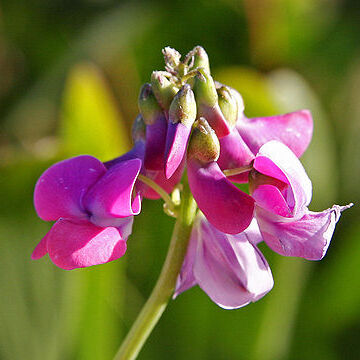Trees, shrubs, or herbs, sometimes climbing or decumbent, very often bearing root-nodules that harbor nitrogen-fixing bacteria. Leaves alternate or rarely opposite, pinnate or bipinnate, less often palmately compound or 3-foliolate, seldom 1-foliolate or simple, or modified into narrow phyllodes; petiole present or absent; stipules and stipels present or absent, sometimes stipules developed into spines. Flowers bisexual, rarely unisexual, actinomorphic (Mimosoideae), ± zygomorphic (Caesalpinioideae) to very zygomorphic (Papilionoideae), mostly in racemes, corymbs, spikes, heads, or panicles. Sepals (3-)5(or 6), free or connate into a tube, sometimes bilabiate, rarely reduced or obsolete. Petals (0-)5(or 6), usually isomerous with sepals, seldom fewer or none, imbricate or valvate, distinct and often highly differentiated into papilionaceous corolla: upper petal (standard) outermost, 2 lateral petals (wings) ± parallel with each other, lower 2 innermost petals usually connate by their lower margins and forming a keel. Stamens mostly 10, sometimes fewer or more numerous, distinct or often connate by their filaments to form a closed or open sheath, monadelphous or diadelphous, anther 2-locular, opening lengthwise or by pores, uniform or dimorphic and then alternately basifixed and dorsifixed; pollen simple or compound. Gynoecium nearly always of a solitary carpel (rarely 2 or more distinct carpels); ovary superior, 1-locular or sometimes transversely, rarely longitudinally septate; ovules 1 to numerous, inserted on adaxial suture. Legumes dehiscent by one or both sutures, or indehiscent, sometimes winged, sometimes jointed and breaking up into 1-seeded segments. Seeds without or with very scanty endosperm, sometimes strophiolate.
Trees, shrubs, sometimes climbers or lianes, or rarely herbs, unarmed or often armed in tribe Caesalpinieae. Leaves mostly alternate, usually pinnate, sometimes bipinnate, rarely unifoliolate or simple or reduced to a phyllode-like rachis; stipules paired, usually small, often caducous, or absent. Inflorescence axillary, terminal or sometimes cauliflorous, commonly paniculate, or reduced to simple racemes or spikes, rarely capitate or flowers solitary; racemes sometimes (by reduction of the main axis) represented by umbelliform fascicles. Flowers small to medium or large, regular or usually ±irregular to strongly irregular, mostly bisexual and 5-merous. Hypanthium absent to elongate and pedicel-like. Sepals usually imbricate, rarely valvate, rarely open from an early stage of bud, free or sometimes ±connate (in archaic genera such as Gleditsia the perianth is not clearly differentiated into two dissimilar series). Petals imbricate in bud, usually with the dorsal one within and overlapped by the adjacent lateral ones, free or sometimes united below, usually 5, sometimes reduced to only 1 or altogether absent. Stamens usually 10 or fewer, rarely numerous, free or ±united below, often of 2 unequal sets or some staminodal; filaments longer or shorter than the anthers; anthers usually dehiscing longitudinally but sometimes with apical or basal pores; pollen grains usually simple. Ovary unicarpellate, free or when stipitate the stipe sometimes ±adnate to the calyx tube; ovules anatropous. Fruit usually elongate, several-to many-seeded and dehiscent but various and sometimes indehiscent, drupaceous or samaroid. Seeds generally without areoles, with an apical or subapical hilum; embryo with a generally straight radicle.
Mostly trees and shrubs, sometimes lianes (Entada ) or herbs (Desmanthus , some Mimosa spp. and Neptunia ), unarmed or with stipular spines or prickles. Leaves alternate, bipinnate or reduced to phyllodes, commonly with extrafloral nectaries on either or both main and secondary axes; stipules rarely absent, but often caducous (persistent and conspicuous in some Neptunia spp.); leaflets (when present) generally opposite, rarely alternate (Adenanthera , Pararchidendron ). Inflorescence globular to oblong clusters, solitary or aggregated in axillary, terminal or cauliflorous/ramiflorous, simple racemes to complex, compound panicles. Flowers sessile or pedicellate, mostly 4-or 5-merous, regular, bisexual, unisexual or some neuter (Dichrostachys , Neptunia ), green, white, cream, yellow, red or purple. Stamens few to numerous; filaments free or united at base or forming a tube, this sometimes adnate with corolla base; anthers dorsifixed or basifixed, sometimes with apical, stalked, caducous gland. Pistil solitary or several, free. Pod dehiscent by one or both margins or indehiscent, sometimes fragmenting in 1-seeded sections (Cathormion , Mimosa ). Seeds oriented transversely, obliquely or longitudinally; pleurogram generally present but sometimes lacking (Archidendron , Archidendropsis and Entada in Australia).

